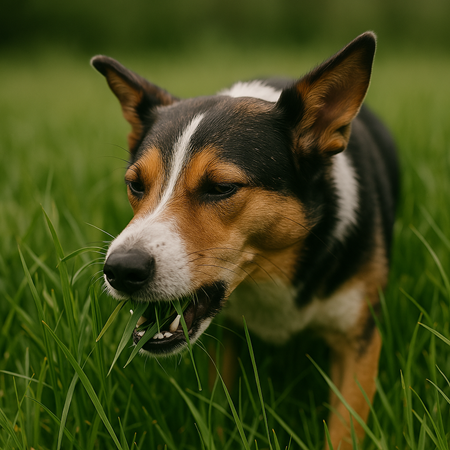
As you may have noticed from your trips to the park, some dogs relish eating grass as though it were a gourmet treat. Others, however, don’t seem overly interested, and may only take an occasional little munch every now and then. Like many dog owners, you’ve probably wondered about this behavior. The definitive answer to the question “Why do dogs eat grass?” has not been found. But experts have some interesting theories.
Natural-Born Scavengers
According to this theory, modern-day domesticated dogs eat grass because, in their evolutionary past, they were scavengers, wild animals that ate whatever they could find when they needed nutrition. Sometimes that included grass. Dogs are omnivores. As omnivores, animals that eat both meat and vegetation, dogs may simply have a natural craving for grass. Some dogs may eat more grass than others because the taste appeals to them more.
Stomach Cleansing
If your dog is fond of grass, you may have noticed that eating grass makes him vomit. The correlation between eating grass and vomiting is well documented, but experts still aren’t entirely clear if dogs eat grass because they feel a need to cleanse their stomachs, or if they vomit because the grass has given them an upset stomach. If it’s the former, then eating grass may be a natural and instinctive way for dogs to purge the contents of their digestive tract. The mystery, however, gets deeper when you consider that some dogs eat grass without any consequences.
When You Should Be Concerned
If your dog has an appetite for an occasional grass snack, this may be perfectly normal behavior. And if it makes him vomit now and then, there may still be no need for alarm. However, if he vomits more than once or twice, or if your non-grass-eating dog suddenly starts eating great quantities of grass, you should have him checked by your vet. This may be an indication that something is wrong with his digestive system. The use of pesticides, herbicides, fertilizers, and other lawn treatments is another cause for concern. If your dog is a grass eater by nature, make sure he can’t snack on any lawn that’s been treated. When in doubt, play it safe and keep him away from questionable patches of grass in the neighborhood or the park.
Fun Facts About Dogs
Sweat glands in dogs are between their paw pads.
Dogs are left or right ‘handed,’ just as humans are.
Dogs trained to guide the blind cannot tell a red light from a green one. They watch the traffic flow to tell when it is safe to cross.
One of the top canine health problems in the U.S. is overweight dogs.
Dogs instinctively turn around before they lay down because in the wild this action turns long grass into a bed.
Dogs have twice as many muscles for moving their ears as humans.
Puppies have 28 teeth, while adult dogs have 42 permanent teeth.
A dog’s heart beats 70 to 120 times per minute, while a human heart beats 70 to 80 times per minute.
The hearing range of a dog is ten times farther than a human’s hearing range.
Dogs share nearly 90% of the same genetic content that humans do, and they inherit many of the same diseases.
Dogs do not have an appendix or a collarbone.
A dog’s nose has over 200 scent receiving cells, 44 times more than humans.
Most dogs are lactose intolerant.
The Bloodhound is the only animal whose (sniffing) evidence is admissible in an American Court of Law.
A dog’s nose is kept moist by fluid from a gland inside his nose. This moisture helps them detect odors.
Dogs and humans are the only animals with prostates.
The average dog’s mouth exerts 150 to 180 pounds of pressure per square inch. Some dogs can apply up to 450 pounds. In comparison, a six-foot alligator exerts a force of about 1,540 pounds between its jaws.
Related Articles & Free Email Newsletter Sign Up
How Humans Developed a Successful Partnership with Dogs
How to Know if Your Dog Has a Food Allergy
Why Your Dog Pants and How it Helps Him


Comment here